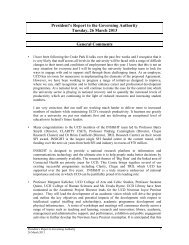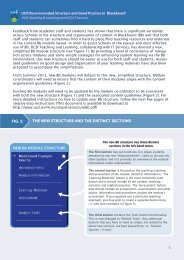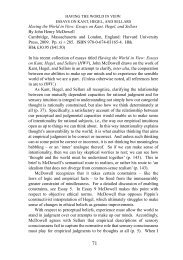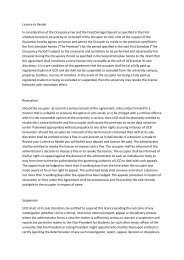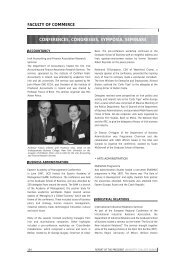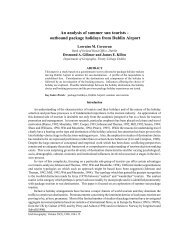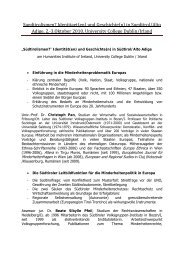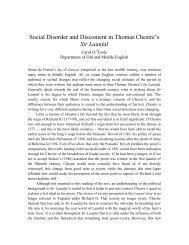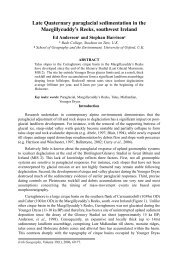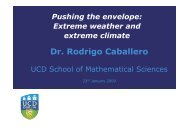Featured in this issue: - University College Dublin
Featured in this issue: - University College Dublin
Featured in this issue: - University College Dublin
You also want an ePaper? Increase the reach of your titles
YUMPU automatically turns print PDFs into web optimized ePapers that Google loves.
virology<br />
Hunt<strong>in</strong>g Down the L<strong>in</strong>ks<br />
Few scientists become celebrities outside their narrow field of specialty. But mention the name of Bob Gallo, the<br />
US virologist who co-discovered HIV, and ears prick up all around. Claire O’Connell spoke to Prof Gallo about his<br />
appo<strong>in</strong>tment as Visit<strong>in</strong>g Professor at UCD.<br />
Thanks to the impact of his work,<br />
and the controversy that has sometimes<br />
surrounded it, Prof Gallo has become a giant<br />
<strong>in</strong> the global fight aga<strong>in</strong>st AIDS. And from<br />
now on you may occasionally spot his<br />
tower<strong>in</strong>g figure around campus - he was<br />
recently appo<strong>in</strong>ted visit<strong>in</strong>g professor to<br />
UCD’s School of Medic<strong>in</strong>e and Medical<br />
Science. His new post formalises a long and<br />
friendly relationship with the <strong>College</strong><br />
through fellow virologist Prof William Hall<br />
(Director of the Centre for Research <strong>in</strong><br />
Infectious Diseases - CRID).<br />
But despite his track record, Prof Gallo<br />
surpris<strong>in</strong>gly <strong>in</strong>sists he had no <strong>in</strong>nate curiosity<br />
about the natural world as he grew up <strong>in</strong> an<br />
Italian-American family <strong>in</strong> Connecticut. “I was<br />
very typical, and I wasn't very serious. I liked<br />
basketball”, he says, hold<strong>in</strong>g up the crooked<br />
little f<strong>in</strong>ger he still sports from a play<strong>in</strong>g <strong>in</strong>jury.<br />
However, family tragedy meant he came <strong>in</strong>to<br />
contact to the medical community more than<br />
most when his sister developed leukaemia and<br />
was treated at Harvard medical school's<br />
hospital. “I saw research doctors at an<br />
impressionable age of 12 or 13 and you hold<br />
that somewhere”, he says.<br />
One doctor <strong>in</strong> particular, Irish pathologist<br />
Marcus Cox, was to become a mentor for the<br />
teenage Gallo. “He was the first cynical<br />
rationalist I ever met. My family was not like<br />
that. He was impolite to people and there was<br />
the disbelief angle of science: prove it to me.”<br />
When Gallo <strong>in</strong>jured his back play<strong>in</strong>g basketball,<br />
he took time to focus on a future career and<br />
Marcus Cox conv<strong>in</strong>ced him to go to medical<br />
school. Follow<strong>in</strong>g his tra<strong>in</strong><strong>in</strong>g at the <strong>University</strong><br />
of Chicago, Gallo next took up a research post<br />
at the National Cancer Institute. The usual track<br />
for medical doctors was to return to cl<strong>in</strong>ical<br />
care, but he saw that research was becom<strong>in</strong>g<br />
more complex and opted to stay <strong>in</strong> the lab.<br />
He developed a passion for hunt<strong>in</strong>g down l<strong>in</strong>ks<br />
between viruses and cancer. This was an<br />
unpopular theory <strong>in</strong> the 1970s, and he felt the<br />
brunt of ma<strong>in</strong>stream disapproval. “It was a<br />
rollercoaster ride. There was a lot of pressure,<br />
there were a lot of criticisms. It was a lonely<br />
bus<strong>in</strong>ess, and I always kept some other work<br />
go<strong>in</strong>g just to show I was able.” But thanks to a<br />
supportive NCI director, Prof Gallo ploughed on<br />
and eventually discovered HTLV-1, the first<br />
human retrovirus, which was associated with an<br />
aggressive form of leukaemia. His approach was<br />
further v<strong>in</strong>dicated when other cancerassociated<br />
viruses came to light <strong>in</strong> later years,<br />
<strong>in</strong>clud<strong>in</strong>g herpes, papilloma and hepatitis.<br />
However by the early 1980s, a mysterious<br />
disease called AIDS was pull<strong>in</strong>g Prof Gallo's<br />
attention. “In 1981 it was identified but noth<strong>in</strong>g<br />
was known really, it was thought to be trivial”,<br />
he recalls. “Half a dozen people here and there,<br />
noth<strong>in</strong>g that would stir your imag<strong>in</strong>ation. But<br />
by early 1982 it was clear.” When a French<br />
team led by Luc Montagnier found a potentially<br />
new virus <strong>in</strong> a patient, they sought Prof Gallo’s<br />
help <strong>in</strong> figur<strong>in</strong>g out what it was. The US team<br />
crucially developed a way to grow the virus <strong>in</strong><br />
cells <strong>in</strong> the lab, allow<strong>in</strong>g the virus to be<br />
analysed, and so HIV was identified and l<strong>in</strong>ked<br />
with AIDS. There followed years of controversy<br />
over who had officially discovered HIV, but<br />
<strong>in</strong> 1987 Gallo and Montagnier were declared<br />
co-discoverers.<br />
Follow<strong>in</strong>g the <strong>in</strong>itial discovery, Prof Gallo’s team<br />
went on to develop the blood test to screen for<br />
HIV, and his lab hosted researchers who<br />
discovered drug therapies to keep the virus<br />
down. His team also discovered that<br />
chemok<strong>in</strong>es produced by the body can <strong>in</strong>hibit<br />
HIV. This opened up new avenues of research<br />
<strong>in</strong>to how the virus attacks cells and raised<br />
possibilities for a vacc<strong>in</strong>e aga<strong>in</strong>st the virus. His<br />
work on the HTLV and HIV retroviruses earned<br />
him a str<strong>in</strong>g of prestigious scientific awards,<br />
<strong>in</strong>clud<strong>in</strong>g an unprecedented two Lasker awards<br />
<strong>in</strong> the 1980s for basic research.<br />
The vacc<strong>in</strong>e is now where Prof Gallo tra<strong>in</strong>s his<br />
research efforts at the Institute of Human<br />
Virology (IHV), which he co-founded and directs<br />
at the <strong>University</strong> of Maryland's School of<br />
Medic<strong>in</strong>e.<br />
He was recently awarded a $15 million grant<br />
from the Bill and Mel<strong>in</strong>da Gates Foundation to<br />
cont<strong>in</strong>ue research <strong>in</strong>to a vacc<strong>in</strong>e that recognises<br />
the shape of the virus as it tries to <strong>in</strong>fect and<br />
weaken cells of the immune system. “The<br />
preventative vacc<strong>in</strong>e is the only way to answer<br />
<strong>this</strong>”, he says. “And ultimately I th<strong>in</strong>k we are<br />
solv<strong>in</strong>g the problem with the vacc<strong>in</strong>e candidate<br />
we have at IHV. However, we also still need to<br />
develop new drug therapies to support people<br />
who are already <strong>in</strong>fected.” And the <strong>issue</strong><br />
rema<strong>in</strong>s of gett<strong>in</strong>g medication to the people<br />
who need it, particularly <strong>in</strong> develop<strong>in</strong>g nations.<br />
Prof Gallo s<strong>in</strong>gs the praises of the US<br />
Government's PEPFAR programme, which funds<br />
cl<strong>in</strong>ical work with local communities <strong>in</strong> HIVravaged<br />
countries, and by next year his own<br />
Institute will treat around 130,000 people<br />
around the world. He also notes the importance<br />
of keep<strong>in</strong>g HIV/AIDS <strong>in</strong> the public eye. “Every<br />
month around 258,000 people die of AIDS, but<br />
does it get the attention?” he asks. “If Eastern<br />
Europe explodes and it starts to come <strong>in</strong>to<br />
Western Europe, then it will get the headl<strong>in</strong>es.”<br />
Before he leaves for a function, Prof Gallo<br />
muses on the presentations he had just heard<br />
from researchers at CRID. “It was a good<br />
13<br />
experience”, he says. “I would say the work was<br />
quite outstand<strong>in</strong>g, they are do<strong>in</strong>g really good<br />
work and the young people are quite mature.”<br />
He now plans to come to UCD twice a year, and<br />
the connection will promote collaborations<br />
with the IHV <strong>in</strong> Maryland, where Prof Bill Hall<br />
sits on the advisory board. “Bill is a great and<br />
much respected scientist and our <strong>in</strong>terests<br />
overlap and complement each other”, he says.<br />
“We speak the same language so it's easy to<br />
collaborate, there are no barriers. And the<br />
people here are so welcom<strong>in</strong>g - nobody would<br />
not want to come over. And vice versa, we<br />
would welcome people to come over and work<br />
<strong>in</strong> our lab.”<br />
Claire O’Connell (BSc 1992, PhD 1998) is a<br />
freelance journalist.<br />
Dur<strong>in</strong>g HIV <strong>in</strong>fection, millions of viral particles are<br />
present <strong>in</strong> the blood stream. They cont<strong>in</strong>uously <strong>in</strong>fect<br />
cells of the immune system. As the immune system<br />
becomes progressively more damaged, HIV disease<br />
becomes more advanced and eventually the Acquired<br />
Immunodeficiency Syndrome (AIDS) develops.<br />
Copyright ©1999 Boehr<strong>in</strong>ger Ingelheim GmbH,<br />
Germany. All rights reserved.<br />
Prof Bob Gallo, Director of the Institute of Human<br />
Virology and Professor of Medic<strong>in</strong>e at the <strong>University</strong> of<br />
Maryland, Baltimore, USA, and Visit<strong>in</strong>g Professor at the<br />
School of Medic<strong>in</strong>e and Medical Science, UCD.



